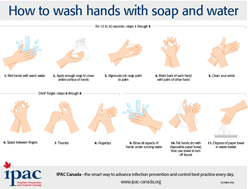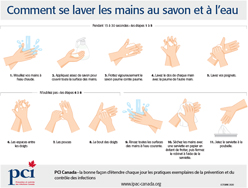- The Rationale for Hand Hygiene
- Hand Hygiene Procedures
- Standards & Guidelines
- Education & Teaching Aids
- Posters & Videos
- Other Information
Information about Hand Hygiene
WHO SAVE LIVES: Clean Your Hands

SAVE LIVES: Clean Your Hands brings people together in support of hand hygiene improvement globally and to progress the goal of maintaining a global profile on hand hygiene in health care.
The campaign aims to galvanize action at the point of care to demonstrate that hand hygiene is the entrance door for reducing health care-associated infection and patient safety. It also aims to demonstrate the world's commitment to this priority area of health care.
WHO's role includes encouraging engagement and action to maintain this global movement. Numbers are a great awareness-raising mechanism, as demonstrated by the growing number of health-care facilities registered for SAVE LIVES: Clean Your Hands but they are not the end point. Sustaining the efforts to improve patient safety requires dedicated action and innovation both of which are now more crucial than ever. WHO have appreciated receiving communications about country and health-care facility activities. Action must continue; use the WHO tools to support your actions.
.png)
World Hand Hygiene Day: May 5th 2025
Why is sharing knowledge about hand hygiene still so important?
- World Hand Hygiene Days 2025
- Join the WHO campaign
- 2025 Campaign Advocacy Toolkit
- Campaign Assets for Download
- WHO Hand Hygiene Implementation Tools and Resources
The Rationale for Hand Hygiene
| IPAC Canada Cleaning Hands (English) |
IPAC Canada Cleaning Hands (French) |
Why is hand hygiene important?
Hand hygiene refers to removing or killing microorganisms (germs) on the hands. When performed correctly, hand hygiene is the single most effective way to prevent the spread of communicable diseases and infections. In health care, hand hygiene is used to eliminate transient microorganisms that have been picked up via contact with patients, contaminated equipment or the environment. Hand hygiene may be performed either by using soap and running water, or with alcohol-based hand rubs.
When should hand hygiene be performed?
In health care, hand hygiene is required:
- Before and after contact with any patient/resident, their body substances or items contaminated by them
- Between different procedures on the same patient/resident
- Before and after performing invasive procedures
- Before preparing, handling, serving or eating food or feeding a patient/resident
- After assisting patients/residents with personal care (e.g. assisting patient to blow nose, toileting or doing wound care)
- Before putting on and after taking off gloves
- After performing personal functions (e.g. using the toilet, blowing your nose)
- When hands come into contact with secretions, excretions, blood and body fluids (use soap and running water whenever hands are visibly soiled)
When should soap and water be used?
The mechanical action of washing, rinsing and drying removes transient bacteria present on the hands. Hand washing with soap and running water must be performed whenever hands are visibly soiled.
Any type of plain soap may be used. However, bar soaps are not acceptable in health care settings except for single patient/resident personal use. If used, bar soap should be kept in a self draining holder that is cleaned thoroughly before new bars are put out. Liquid soap containers should be used until empty and then discarded. Soap containers must not be topped up, as there is a risk of contamination of residual soap. Antibacterial soaps may be used in critical care areas such as ICU, or in other areas where invasive procedures are performed.
When should alcohol-based hand rubs be used?
Alcohol-based hand rubs/gels/rinses are the preferred method for decontaminating hands, provided they contain more than 60% alcohol. They are widely used in health care settings, or in situations where running water is not available. Using alcohol-based hand rub is better than washing hands (even with an antibacterial soap) when hands are not visibly soiled.
Won't frequent hand hygiene dry my skin?
Intact skin is the first line of defence against microorganisms, hence it is important to maintain good skin care. To prevent chafing, wet your hands before applying soap and use a mild lotion soap with warm water; pat rather than rub hands dry; and apply lotion liberally and frequently. Skin lotions should be chosen that will not interfere with glove integrity.
Most alcohol-based hand rubs contain emollients to reduce the incidence of skin irritation. Frequen use of alcohol-based hand rub actually lessens the incidence of skin breakdown, as it does not subject hands to the friction and abrasion involved in hand washing and drying hands.
If an individual develops compromised skin integrity, he/she should be referred to Occupational Health for assessment.
Hand Hygiene Procedures
How do I use soap and water?
Good hand hygiene technique is easy to learn. Follow these five simple steps to keeping hands clean:
- Remove hand and arm jewellery and wet your hands with warm (not hot) running water.
- Add soap, and then rub your hands together, making a soapy lather. Do this for at least 15 seconds, being careful not to wash the lather away. Wash the front and back of your hands, as well as between your fingers and under your nails.
- Rinse your hands well under warm running water, using a rubbing motion.
- Wipe and dry hands gently with paper towel. Rubbing vigorously with paper towels can damage the skin.
- Turn off tap using paper towel so that you do not recontaminate your hands.
- Hand Hygiene E-learning Tool -Infection Prevention and Control Canada and Discovery Campus offer an online hand hygiene education module for healthcare workers and volunteers
How do I use alcohol-based hand rubs?
Alcohol-based hand rubs should only be used if no visible dirt is present on the hands.
- Remove hand and arm jewellery.
- Apply enough alcohol-based hand rub to make about the size of a quarter onto your hands, enough when you rub your hands together to cover all areas of your hands, including under your nails (1-2 pumps).
- Use a rubbing motion to evenly distribute the alcohol-based hand rub over all surfaces of the hands, particularly between fingers, fingertips, back of hands and base of thumbs.
- Rub hands until your hands feel dry (minimum 15-30 seconds).
What are some mistakes I should avoid regarding hand hygiene?
- DON'T leave hand jewellery on when performing hand hygiene. Jewellery is very hard to clean and hides bacteria and viruses from the mechanical action of the washing/rubbing.
- DON'T use artificial nails, nail enhancements or long (>3-4mm) nails, as they trap bacteria and are difficult to keep clean.
- DON'T wear chipped nail polish, as bacteria may become trapped along the edges
- DON'T use a single damp cloth to wash a group of patient's/resident's/children's hands.
- DON'T use a standing basin of water to rinse hands.
- DON'T use a common hand towel.
- DON'T use sponges or non-disposable cleaning cloths. Remember that germs thrive on moist surfaces.
Standards and Guidelines
- IPAC Canada Practice Recommendation: Hygiene in Healthcare Settings (October 2022)
- SHEA/IDSA/APIC Practice Recommendation: Strategies to prevent healthcare-associated infections through hand hygiene: 2022 Update
- IPAC Canada Cleaning Hands (English) & IPAC Canada Cleaning Hands (French
- Best Practices for Hand Hygiene in All Health Care Settings - Ontario's Provincial Infectious Diseases Advisory Committee (PIDAC) 2014
- Hand Hygiene Practices in Healthcare Settings - Public Health Agency of Canada (PHAC) 2013
- Guideline for Hand Hygiene in Health-Care Settings - Recommendations of the Healthcare Infection Control Practices Advisory Committee and the HICPAC/SHEA/APIC/IDSA Hand Hygiene Task Force
- Just Clean Your Hands -Public Health Ontario's evidence-based hand hygiene program for hospitals and long-term care homes
- Hand Hygiene Training Videos and Tools for Hospitals (Public Health Ontario)
- Hand Hygiene Training Videos and Tools for Long-term Care (Public Health Ontario)
- Just Clean Your Hands Videos (Public Health Ontario)
- Alberta Health Services interactive hand hygiene reviewer training modules: Modules 1-10
- PICNet's Hand Hygiene Resource Page Resources from the Provincial Infection Control Network of British Columbia (PICNet) include
- Hand Hygiene Guidelines (PICNet)
- Hand Hygiene Educational Resources -fact sheets, diagrams, signage, interactive tools (PICNet)
- BC CDC Hand Hygiene Resources
- WHO SAVE LIVES: Clean Your Hands -The World Health Organization's hand hygiene program undertaken as part of the First Patient Safety Global Challenge, Clean Care is Safer Care
- Join the WHO Hand Hygiene Campaign
- WHO Hand Hygiene Implementation Tools and Resources
Education and Teaching Aids
- Infection: Don't Pass It On Campaign A project of the U.S. Department of Veterans Affairs, with the messages "Wash your hands" and "Cover your coughs". Many educational materials available, including:
- Germs. Wash your Hands of Them & Children's Pack -Scotland's National Hand Hygiene Campaign has useful information, posters and other resources available
- Hand Hygiene Resource Web Page (CDC)
- Hand Hygiene Interactive Training Course (CDC)
- Hand Hygiene Saves Lives - patient and visitor video (CDC)
- Hand Hygiene Education Courses (CDC)
Videos
- Public Health
- Hand Hygiene (Peel Public Health)
- Wash Those Hands! (Lincoln-Lancaster County Health Dep't, Nebraska - posters, table tents, activity sheets)
- Scrub Club (Hand hygiene games for kids from NSF International)
- You'll Like Clean Hands (Winnipeg Health Region)
- Hand Hygiene after a Disaster (CDC) Flyers, stickers and handout cards are available for use when handwashing facilities have been interrupted:
- Just Clean Your Hands Videos (Public Health Ontario)
- Just Clean Your Hands
- Centers for Disease Control and Prevention -Patient Admission Video - long version & Patient Admission Video - short version
Other
- New England Journal of Medicine -Hand Hygiene Video [Longtin, Sax, Allegranzi, Schneider, Pittet - N Engl J Med 2011; 364:e24]
- Proper Hand Washing, Teeth Brushing and Other Hygiene Practices
- Henry the Hand
- Hand Hygiene Facts You Should Know (Filters Fast)
- The Scrub Club
- Children's Pack
- The National Health Museum Classic Collection: Handwashing
- Ignaz Semmelweis and the Birth of Infection Control (QSHC online)
- Handwashing in Medicine: infrequent use of an ancient practice (Int J Psychosom.)
- A history of hand washing: seven hundred years at a snail's pace (Pharos Alpha Omega Alpha Honor Med Soc.)










